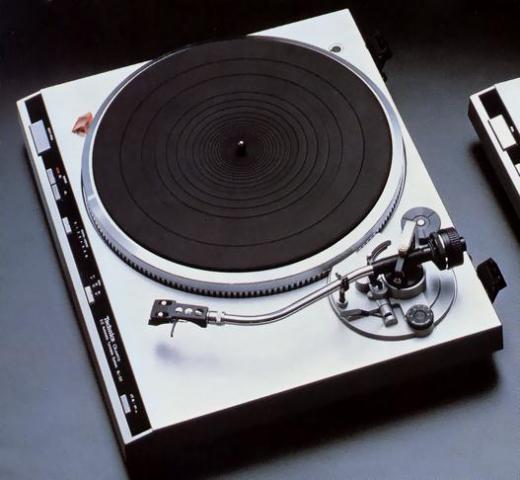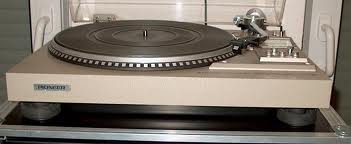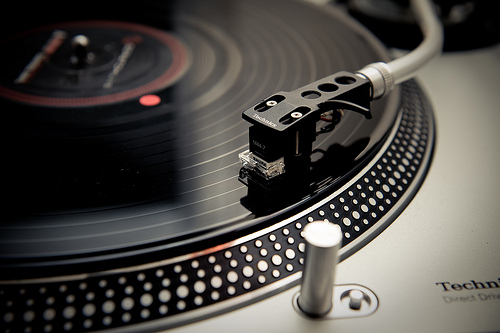So you want to listen to your dad's awesome Led Zeppelin records but you don't have a turntable to play them on. Here's a down and dirty quick guide to buying a quality vintage turntable at an affordable price. Do this and save your money for vinyl.



But first, why go vintage? Why not get a brand turntable, or one of those USB devices that hooks directly to your computer.
Well, forget about those cheap USB turntables. They will play a record, but they will also likely damage your records over time, as they lack the ability to set the needle pressure on the record. BTW, this is called tracking force and you will definitely want a turntable with this ability. Those USB tables are lightweight and made from plastic. For a little bit more money you can get a high quality vintage table, put on a new needle assembly (called a stylus) and have a piece of equipment that will likely last the rest of your life. The difference between a USB table and a vintage Technics or Dual table is like having a beater car instead of an Audi, and if you find the right table, it's more like having a Delorean.
So what about new turntables? There are several in the $400-600 range that are super nice. Both Rega and Pro-Ject make entry level tables at this price, but you can get better quality than entry level for less money, if you buy used and vintage. Before I discuss what features you should look for, I should tell you where to find tables. Flea Markets and yard sales are going to get you a table for the lowest price. I've bought tables for as little as $25 that worked well after a new needle and stylus, and sometimes a new drive belt. My current table, a Pioneer PL-518 was a yard sale buy for $15. I spent a little extra for an upgrade Orofon styles ($75), but for less than $100, I have a table as good as any new turntable in the $1,000 range. You should check out Goodwill and other charity store outlets. Also, Goodwill has an online auction, at www.shopgoodwill.com that always has turntables for decent prices.
Next stop on the availability chart is Craigslist. The best advantage here is you can test the table first, and sometimes you will come across an experienced audiophile who will help you with getting set up. Finally if all else fails, or if you want a ready to go, doesn’t need anything done table, check out your local record store. These tables have usually been cleaned, oiled, and come with a new needle or stylus. Unless you buy a turntable at record store with some form of guarantee, you should absolutely count on spending some additional money for a new needle or stylus. The stylus is the whole tip assembly, whereas the needle is usually just a diamond tip on a plastic holder. The stylus costs a little more money but I would always go that route. There is a big difference in tonal quality between brands, and between models in a brand, so visit www.needledoctor.com for some help in picking a stylus for your vintage table.
So there you are standing in front of a turntable at a yard sale, cash in hand and you realize you don't know what you are suppose to be looking at or for. Here it is. Turntables are either belt drive or direct drive. It will usually tell you on the case what it is, but sometimes it's in the model number; like SD-220 is a direct drive; while SBD-220 is a belt drive. Audiophiles argue all day over the merits of each, don’t get bogged down in that for your first turntable. It doesn't much matter except you will probably want to put on a new belt, which will cost about $10 and take 15 minutes if you are handy. Not handy you say? Stick with direct drive turntable. Pro tip here, the heavier the table, the better it is likely to be. It's engineering pure and simple. Mass reduces the possibility of casual vibration causing the needle to jump, so heavy is better.
Look at the tone arm. Does it have a hunk of metal hanging on the back end, like one of the pictures above. This is very good and is mandatory on any table you buy. This is the tracking counterweight adjustment, the thing that controls how much pressure and wear your needle will have on a record. No big hunk dangling on the tone arm end, walk away. It’s really that simple. Heavy well built table and counterweight. Everything else is icing on the cake.
Some tables have auto return function which make the arm go back to the cradle when the record is done playing. Not needed, but a nice feature. Some have a cueing lever which lets you raise the needle and position above the record and then have it slowly set down. Very nice feature and present on most better tables, but if you have a steady hand and no money, cueing can be bypassed for now. You might find a table with fancy lights and dials around the spinning platter. This is usually found on direct drive tables and lets you speed up or slow down the platter for an 33-1/3 or 45 rpm speed. Nice feature but not mandatory in a starter turntable. Most tables will only have 33-1/3 and 45 rpm speed settings and that's ok unless you want to play Grandpop's Tommy Dorsey 78's. In addition to the power cord, the table should have a thin wire in the back which is the ground. This gets connected to the receiver and eliminates any motor hums or noises. No wire there? Well you may have to add it and that's requires some handiness, so keep that in mind. A couple of other features I like; spring load feet or even heavy feet. Better tables have feet with shock absorbers or extra mass built in. Not mandatory but usually indicates a better quality table. Most tables should have a plastic dust cover. They break all the time, but you can buy replacements on line. You will see a lot of yard sale and craigslist table with dust covers. It’s not deal killer, but budget an extra $20-30 to get one on.
So here it is in summary; belt drive or direct drive - doesn't matter if you are handy, otherwise go with direct drive for your first table. Counterweight is mandatory; buy a new stylus and needle for any table you get; heavy turntable and lots of mass is a big plus; ground wire - needed; dust cover - nice but can be bought later; shock aborsption - added plus. How much is that dogie going to cost you? $20 to $150 for a turnatable depending on where you buy it; $50-90 for a new stylus and needle; $10-20 for a belt drive unit. So for anywhere from $75 to $300 you can get a vintage table that will play superbly and last a lifetime. What about brands, are they all equal? No, but stick with these brands and you will be fine; Technics, Panasonic, Dual, Marantz, Fisher. With the exception of the Marantz, you will find any or all of these tables easily if you look. Good hunting.
Bookmark our blog and come back often. There will be columns on different music but also future columns on completing a starter system, cleaning records, storing them and of course collecting vinyl records.
Sansui P-50 belt drive with a standard stylus mount.
Dual 1229 - all Duals have great German engineering and are a superior choice for a turntable.
This model is 3 speed.
Technics SL-221 belt drive. Easy to find table; easy on the wallet.


